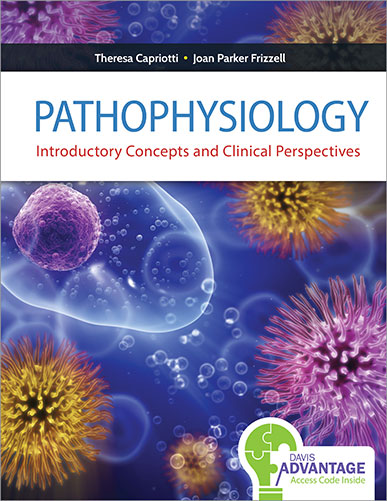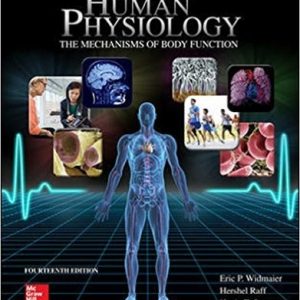Instant download Pathophysiology Introductory Concepts Capriotti Frizzell Test Bank pdf docx epub after payment.

Product details:
- ISBN-10 : 080361571X
- ISBN-13 : 978-0803615717
- Author:
This easy-to-understand text introduces the pathophysiologic processes of the common conditions that you’ll encounter in clinical settings. Chapters organized by organ systems help you understand the relationships between the pathologic event and the patient assessment data, laboratory findings, and diagnostic testing results. You’ll develop the foundational knowledge you need to effectively select the appropriate nursing interventions to deliver the best patient care.
Table of contents:
- UNIT 1: The Cell
- Chapter 1: The Cell in Health and Illness
- Cell Structure and Function
- Chapter 2: Cellular Injury, Adaptations, and Maladaptive Changes
- Basic Concepts of Cellular Adaptations and Maladaptive Changes
- Basic Concepts of Cellular Injury
- Cell Degeneration and Death
- Clinical Interventions to Reverse Cell Injury
- Interventions to Treat Permanent Cell Injury
- Chapter 3: Genetic Basis of Disease
- Basic Concepts of Genetics
- Genetic Assessment
- Gene Therapy
- Ethical Concerns
- Pathophysiology of Selected Genetic and Chromosomal Disorders
- UNIT 2: Integrated Body Processes
- Chapter 4: Stress, Exercise, and Immobility
- The Effects of Stress
- Treatment of Stress
- The Beneficial Effects of Exercise
- The Harmful Effects of Physical Inactivity and Immobility
- Interventions to Counteract Effects of Immobility
- Chapter 5: Obesity and Nutritional Imbalances
- Epidemiology
- Etiology
- Pathophysiology
- Risk Factors
- Clinical Manifestations
- Diagnosis
- Treatment
- Nutritional Imbalances
- Eating Disorders
- Chapter 6: Pain
- Epidemiology
- Basic Concepts Related to Pain
- Basic Pathophysiologic Concepts Related to Pain
- Types of Pain
- Sources of Pain
- Pain Assessment
- Treatment
- Selected Clinical Pain Syndromes
- UNIT 3: Fluid, Electrolyte, and Acid-Base Homeostasis
- Chapter 7: Fluid and Electrolyte Imbalances
- Basic Concepts of Fluid and Electrolyte Balance
- Basic Pathophysiologic Concepts of Fluid and Electrolyte Imbalance
- Assessment of Fluid Volume Status
- Electrolyte Imbalances
- Chapter 8: Acid-Base Imbalances
- Basic Concepts of Acid–Base Balance
- Pathophysiologic Concepts Regarding Acid–Base Imbalances
- UNIT 4: Infection and Inflammation
- Chapter 9: Inflammation and Dysfunctional Wound Healing
- Inflammation and the Inflammatory Response
- Tissue Repair and Wound Healing
- Chapter 10: Infectious Diseases
- Basic Concepts of Infection
- Selected Bacterial Infections
- Selected Viral Infections
- Selected Fungal Infections
- Candida
- Selected Parasitic Infections
- Chapter 11: Disorders of the Immune System
- Basic Concepts of Immunity
- Vaccines
- Hypersensitivity
- Pathophysiology of Selected Autoimmune Disorders
- Pathophysiology of Selected Immunodeficiency Disorders
- HIV Infection
- UNIT 5: Hematologic Disorders
- Chapter 12: Disorders of White Blood Cells
- Epidemiology
- Basic Concepts of White Blood Cell Function
- Basic Concepts of White Blood Cell Pathophysiology
- Pathophysiology of Selected White Blood Cell Disorders
- Chapter 13: Disorders of Red Blood Cells
- Epidemiology
- Basic Concepts of Red Blood Cell Physiology
- Basic Concepts of Red Blood Cell Pathophysiology
- Pathophysiology of Selected Red Blood Cell Disorders
- Chapter 14: Disorders of Platelets, Hemostasis, and Coagulation
- Epidemiology
- Basic Concepts of Bleeding and Clotting Physiology
- Basic Concepts of Bleeding and Clotting Pathophysiology
- Assessment of Bleeding and Clotting Disorders
- Treatment
- Pathophysiology of Selected Coagulation Disorders
- UNIT 6: Disorders of Cardiovascular Function
- Chapter 15: Arterial Disorders
- Basic Physiological Concepts of Arterial Structure and Function
- Pathophysiology of Arterial Disorders
- Chapter 16: Ischemic Heart Disease and Conduction Disorders
- Structure and Function of the Heart
- The Conduction System
- Selected Pathophysiological Disorders of the Heart
- Chapter 17: Heart Failure
- Basic Physiological Concepts of Heart Function
- Basic Pathophysiological Concepts of Heart Failure
- Chapter 18: Valvular Heart Disease
- Epidemiology
- Basic Concepts of Cardiac Valve Function
- Basic Pathophysiological Concepts of Heart Valve Dysfunction
- Assessment of Cardiac Valve Dysfunction
- Pathophysiology of Selected Heart Valve Disorders
- Chapter 19: Disorders of the Venous System
- Epidemiology
- Basic Concepts of Venous Structure and Function
- Basic Pathophysiological Concepts of Venous Dysfunction
- Pathophysiology of Selected Venous Disorders
- UNIT 7: Pulmonary Disorders
- Chapter 20: Respiratory Inflammation and Infection
- Epidemiology
- Basic Physiological Concepts of Respiratory Function
- Gas Exchange
- Basic Pathophysiological Concepts of Respiratory Function
- Assessment
- Pathophysiology of Selected Upper Respiratory Tract Disorders
- Pathophysiology of Selected Lower Respiratory Tract Disorders
- Chapter 21: Restrictive and Obstructive Pulmonary Disorders
- Epidemiology
- Basic Concepts of Pulmonary Structure and Function
- Basic Pathophysiological Concepts of Pulmonary Disorders
- Pulmonary Assessment
- Treatment
- Pathophysiology of Selected Obstructive Disorders
- Pathophysiology of Selected Restrictive Disorders
- Pathophysiology of Selected Pulmonary Vascular Disorders
- UNIT 8: Renal and Urological Disorders
- Chapter 22: Renal Disorders
- Epidemiology
- Basic Concepts of Renal Function
- Basic Pathophysiological Concepts of Renal Disorders
- Assessment
- Treatment
- Pathophysiology of Selected Disorders
- Chapter 23: Urological Disorders
- Epidemiology
- Basic Concepts of Urological Function
- Basic Pathophysiological Concepts of Urological Function
- Assessment
- Treatment
- Pathophysiology of Selected Urological Disorders
- UNIT 9: Hormonal and Reproductive Disorders
- Chapter 24: Endocrine Disorders
- Epidemiology
- Basic Concepts of Endocrine Function
- Basic Pathophysiological Concepts of Endocrine Dysfunction
- Assessment
- Treatment
- Pathophysiology of Selected Endocrine Disorders
- Chapter 25: Diabetes Mellitus and the Metabolic Syndrome
- Epidemiology
- Etiology of Diabetes
- Basic Concepts of Carbohydrate Metabolism
- Classification of Diabetes
- Pathological Mechanism of Type 1 Diabetes
- Clinical Manifestations of Type 1 Diabetes
- Pathological Mechanism of Type 2 Diabetes
- Clinical Manifestations of Type 2 Diabetes
- Gestational Diabetes Mellitus
- Diagnosis of Diabetes Mellitus
- Complications of Diabetes Mellitus
- Treatment of Diabetes
- Chapter 26: Disorders of the Female Reproductive System
- Epidemiology
- Basic Concepts of Female Reproduction
- Basic Pathophysiological Concepts of Female Reproductive Disorders
- Assessment
- Treatment
- Pathophysiology of Selected Female Reproductive Disorders
- Chapter 27: Disorders of the Male Reproductive System
- Epidemiology
- Basic Concepts of Male Reproductive Function
- Basic Concepts of Male Reproductive Dysfunction
- Assessment of Male Reproductive Disorders
- Common Treatments for Male Reproductive Disorders
- Disorders of the Male Reproductive System
- Chapter 28: Sexually Transmitted Infections
- Epidemiology
- Basic Concepts of Sexual Disease and Dysfunction
- Pathophysiology of Sexually Transmitted Infections
- Sexual Health Care Needs and the LGBTQ Patient Population
- UNIT 10: Gastrointestinal Disorders
- Chapter 29: Disorders of the Esophagus, Stomach, and Small Intestine
- Epidemiology
- Basic Concepts of Esophageal, Stomach, and Small Intestine Function
- Basic Pathophysiological Concepts of the Esophagus, Stomach, and Small Intestine
- Disorders of the Esophagus, Stomach, and Small Intestine
- Chapter 30: Common Disorders of the Large Intestine
- Epidemiology
- Basic Concepts Regarding Function of the Large Intestine
- Basic Concepts of Pathophysiology of Large Intestine Dysfunction
- Assessment
- Treatment of Large Intestine Disorders
- Pathophysiology of Specific Disorders of the Large Intestine
- Chapter 31: Infection, Inflammation, and Cirrhosis of the Liver
- Epidemiology
- Basic Concepts of Liver Function
- Basic Pathophysiological Concepts of Liver Dysfunction
- Assessment
- Treatment
- Select Pathophysiological Disorders of the Liver
- Chapter 32: Gallbladder, Pancreatic, and Bile Duct Dysfunction
- Epidemiology
- Basic Concepts of Gallbladder, Pancreas, and Biliary Function
- Basic Pathophysiological Concepts of Gallbladder, Pancreas, and Biliary Dysfunction
- Assessment of Gallbladder, Pancreatic, and Biliary Tract Disorders
- Treatment of Gallbladder, Pancreatic, and Biliary Tract Disorders
- Pathophysiology of Select Disorders of the Gallbladder, Pancreas, an
People also search:
pathophysiology introductory concepts and clinical perspectives
pathophysiology introductory concept
what is physiology and pathophysiology
which is not a key concept or theme in physiology
what is the pathophysiology of something





